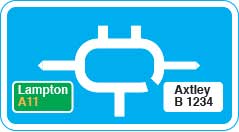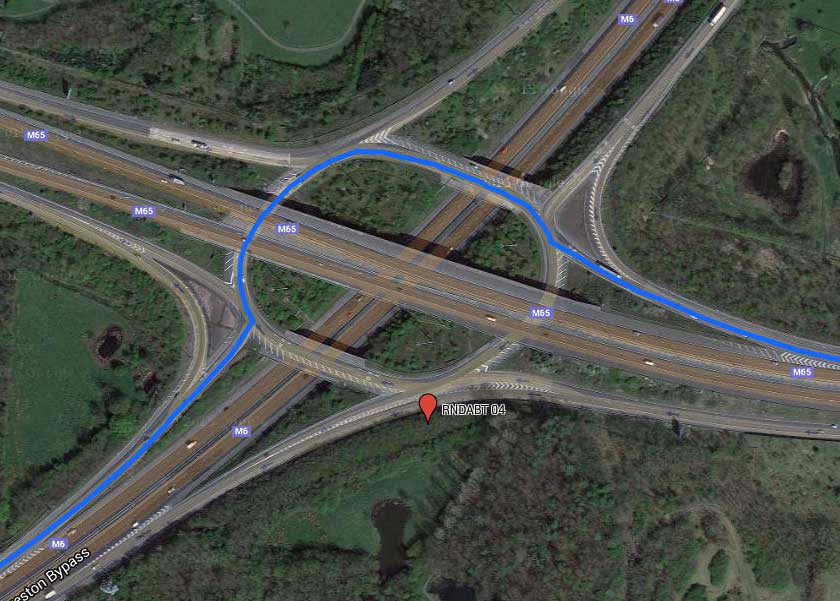Driving in the UK
Fortunately I never had to drive during our UK trip. My friend Lee and my husband Jim were the registered drivers for our rental (each driver costs extra), while I and the other Jim acted as co-pilots/back-seat drivers.
In the UK, of course, you drive on the left-hand side, but both drivers said that driving on the left wasn’t too difficult, especially as any directions from co-pilots were like this: “Take the next right and keep left,” and “Turn left … and keep left.” Right turns, I understand, were understandably more difficult, but I can’t remember a single incident when either driver was on the wrong side. Once on a divided motorway, the distinction disappears other than trying to remember that the far right lane is the fast lane.
Instead, roundabouts were the most difficult challenge to the drivers. If you’re unfamiliar with the concept, instead of a simple intersection where two or more roads meet, most UK streets meet in a roundabout. Cars enter the roundabout driving clockwise and yielding to other cars already in the roundabout. You peel off the roundabout by making a left turn. There is usually an island in the center of the roundabout, but some of the smaller roundabouts may only have a painted circle, which you’re still supposed to treat as no man’s land.

The roundabout challenge consists of several parts: knowing which exit to take, whether you’re making a left or “right” turn and gauging the intent of drivers already in the roundabout. We opted for a voice navigation system for our Hertz rental car (which the others insisted calling Siri to my irritation). The spoken instructions solved two of these challenges, with instructions like, “In two hundred yards, turn right on the roundabout, fourth exit, B 1234.”
Reading the sign properly takes a bit of skill. You’re always approaching the street from the six o’clock position and you can read the sign like a clock face. In this example, the first exit you’ll encounter will be the turnoff for the A11, while the fourth exit, the B 1234, is the one you want. Any exits on the left-hand side of the clock face (six, seven, eight, nine, 10, 11 and up to 12 o’clock) is considered a left turn. Exits from one to five o’clock are considered right-hand turns, even though all exits from the roundabout will require a left-hand turn. Twelve o’clock is considered straight ahead (even though you can’t drive through the middle of the roundabout), but still a left-hand turn.

I believe the theory of a roundabout is that it results in self-regulating traffic flow instead of the surges caused by traffic signals. From my experience as a passenger, it does work but it also results in overly complicated motorway exits and the bewildering experience of one roundabout feeding into another roundabout. Even the smallest intersection in the smallest village seems to require a roundabout. On motorways, where a US road would use a cloverleaf, a UK road will use a giant roundabout that goes over the motorway or two roundabouts on either side.
Knowing whether you’re making a left- or right-hand turn on the roundabout is only important if you’re entering a multiple lane roundabout. If you’re turning right (after 12 o’clock) in a two-lane roundabout, then you should be in the right-hand or inside lane of the roundabout until you’re ready to exit. Usually if you approach a multiple lane roundabout, you’re already driving on a road with more than one left-hand lane. A road sign will indicate which lane you should be if you’re taking the first exit, going straight ahead or turning right. There will probably be markings on the road surface itself indicating which lane corresponds to the exit you wish to take.
First exits are easy. You approach the roundabout in the left lane, slow as you approach the give way line (a dashed white line), and enter the roundabout when the traffic to your right is clear. This is the other big challenge to roundabouts: you need to sense when an approaching car is going to exit onto the street you are on, because that car will give you time to enter the roundabout.
Straight through is also easy because you treat it as a left turn.
Right turns (anything after 12 o’clock) require staying to the inside (or appropriately marked inner lane) until you approach your exit, then you signal to get into the outside lane before exiting. Unfortunately as a foreign driver, you really don’t know the size or exact shape of the roundabout, so there is some guesswork involved. Expect to be honked at.
It can also be a challenge to keep track of which exit you want. Looking at the sign, you see that you want the fourth exit, but some of the exits can be little more than car park entrances and you won’t know whether to count those (you should) and some exits don’t leave the roundabout at 90°, making it easy to miss those. Another challenge is that sometimes the give way line (basically a yield) is controlled by a traffic signal. With so many things for a foreign driver to keep track of, it can be easy to lose sight of that signal, especially because it will be to your right and you’re probably already looking right to watch traffic already in the roundabout.
This video will prove invaluable (although it may give you cold sweats thinking about it):
As a foreigner, you’ll probably find UK road signs quite bewildering. I’d recommend you at least glance at this sign booklet and read the Official Highway Code before your visit. I’d also recommend you get a voice navigation system, especially for the roundabouts. Sadly, they are not so precise as to know what lane you should be in for your exit, but otherwise they are remarkably accurate. We did, however, greatly benefit by having my iPad with GPS and saved Google maps for destinations it was difficult to program into the navigation system. It also helped when the navigation system’s penchant for the most direct possible path sometimes meant unnecessarily traveling incredibly narrow rural roads.
Don’t rent a car with manual gearing. Trying to shift with your left hand might make your head explode.
Motorway driving
Driving something like the M8 isn’t that much more difficult than any interstate highway in the U.S., except that you have to remember you will usually exit to the left, not the right. The far right lane is the fast lane and top speed is usually 70 mph. All signs reflect English, not metric, measurements. The navigation system was very helpful, showing both the current speed limit and our actual speed.
One of the challenges of traveling the motorways is knowing, when looking at a map, when to exit for services. It’s easy to forget when tracing a motorway with your finger that you’ll exit to the left, not the right. If a service is on the opposite side of the road to you, sometimes you’ll need to exit considerably ahead. Services on the motorways can be considerably far apart. Once you do find services, though, you’ll often be pleasantly surprised. Services usually include not only gas stations and restrooms, but often restaurants and even small grocery stores and Wifi. The services will remind older travelers of the places you might have found in the 1960s along East Coast turnpikes. As much as possible, we avoided the services that feature American chains. (One services we stopped at had a Subway sandwich stop and we reluctantly ordered there. It was almost exactly like a U.S. store, but no oil and vinegar for the sandwich.)
Rural roads
Driving a rural road in the U.K. is nerve-wracking. Posted speed limits are ridiculously high considering every road seems to be one lane, even though they occasionally resort to the fiction of a center line. If you’re an impatient driver, definitely read the sign booklet to understand the passing lane road markings as they’re rather confusing. We never passed anyone; it would have been suicide.
City driving
We avoided it like the plague.
